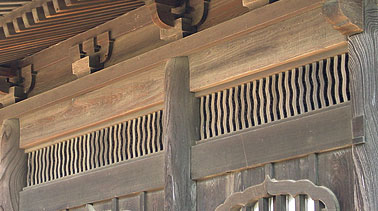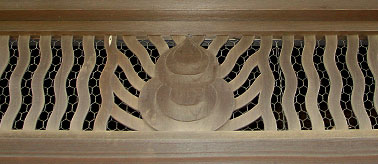| Also
called namiranma gΤ (wave-patterned slats), takewaki ranma §OΤ (vertical billow-patterned slats in a transom) or yumirenji |Aq (bow-shaped slats in transoms). Lit. bow-patterned slats in a transom. Thin
curvilinear slats that are set vertically into a transom. A transom of this
type is characteristic of the Zen style *zenshuuyou T@l. It is normally placed between the head-penetrating tie beam *hinuki ςΡ, and the neck penetrating tie beam hinuki. Occasionally, flame-like
shapes with diagonal wavy slats kaen houju Ξσμ, surround the sacred
hall on each side. This form is placed at the center of each of the eight
sections of transoms at the octagonal pagoda found at Anrakuji ΐy (Kamakura
period) in Nagano prefecture, and at the temple, Shoufukuji Jizoudou ³n °
(1408; a 3x3 bay hall) in Tokyo. |




